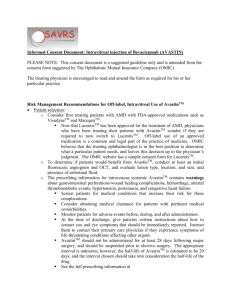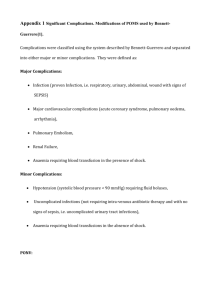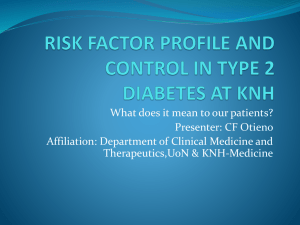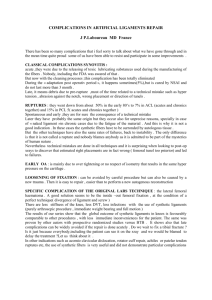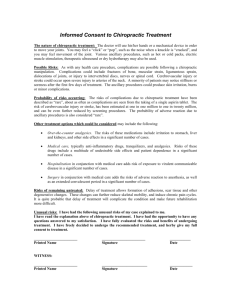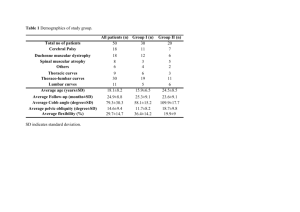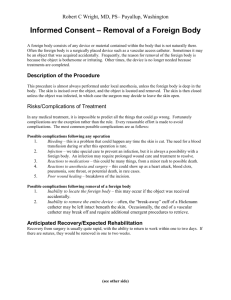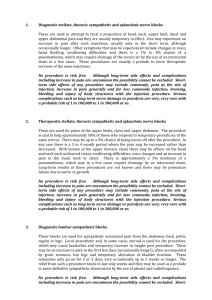informed consent for - Washington Pacific Eye Associates
advertisement
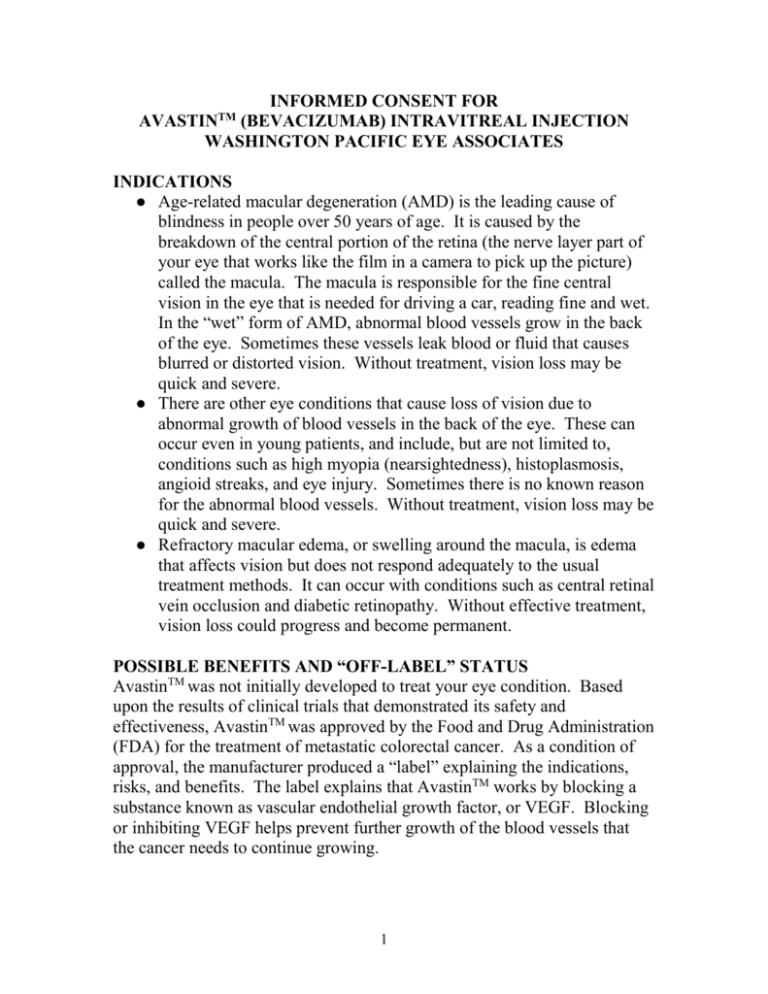
INFORMED CONSENT FOR AVASTIN (BEVACIZUMAB) INTRAVITREAL INJECTION WASHINGTON PACIFIC EYE ASSOCIATES TM INDICATIONS ● Age-related macular degeneration (AMD) is the leading cause of blindness in people over 50 years of age. It is caused by the breakdown of the central portion of the retina (the nerve layer part of your eye that works like the film in a camera to pick up the picture) called the macula. The macula is responsible for the fine central vision in the eye that is needed for driving a car, reading fine and wet. In the “wet” form of AMD, abnormal blood vessels grow in the back of the eye. Sometimes these vessels leak blood or fluid that causes blurred or distorted vision. Without treatment, vision loss may be quick and severe. ● There are other eye conditions that cause loss of vision due to abnormal growth of blood vessels in the back of the eye. These can occur even in young patients, and include, but are not limited to, conditions such as high myopia (nearsightedness), histoplasmosis, angioid streaks, and eye injury. Sometimes there is no known reason for the abnormal blood vessels. Without treatment, vision loss may be quick and severe. ● Refractory macular edema, or swelling around the macula, is edema that affects vision but does not respond adequately to the usual treatment methods. It can occur with conditions such as central retinal vein occlusion and diabetic retinopathy. Without effective treatment, vision loss could progress and become permanent. POSSIBLE BENEFITS AND “OFF-LABEL” STATUS AvastinTM was not initially developed to treat your eye condition. Based upon the results of clinical trials that demonstrated its safety and effectiveness, AvastinTM was approved by the Food and Drug Administration (FDA) for the treatment of metastatic colorectal cancer. As a condition of approval, the manufacturer produced a “label” explaining the indications, risks, and benefits. The label explains that AvastinTM works by blocking a substance known as vascular endothelial growth factor, or VEGF. Blocking or inhibiting VEGF helps prevent further growth of the blood vessels that the cancer needs to continue growing. 1 Once a device or medication is approved by the FDA, physicians may use it “off-label” for other purposes if they are well-informed about the product, base its use on firm scientific method and sound medical evidence, and maintain records of its use and effects. Ophthalmologists are using AvastinTM “off-label” to treat AMD and similar conditions since research indicates that VEGF is one of the causes for the growth of the abnormal vessels that cause these conditions. Some patients treated with Avastin TM had less fluid and more normal-appearing maculas, and their vision improved. AvastinTM is also used, therefore, to treat macular edema, or swelling of the macula. POSSIBLE LIMITATIONS AND ADMINISTRATION The goal of treatment is to prevent further loss of vision. Although some patients have regained vision, the medication may not restore vision that has already been lost, and may not ultimately prevent further loss of vision caused by the disease. After the pupil is dilated and the eye is numbed with anesthesia, the medication is injected into the vitreous, or jelly-like substance, in the back chamber of the eye. AvastinTM is administered by an injection into your eye as needed at regular intervals (about every four to six weeks); your ophthalmologist will tell you how often you will receive the injection, and for how long. ALTERNATIVES You do not have to receive treatment for your condition, although without treatment, these diseases can lead to further vision loss and blindness, sometimes very quickly. Other forms of treatment are available. At present, there are three FDA-approved treatments for neovascular age-related macular degeneration: photodynamic therapy with a drug called VisudyneTM, injection into the eye of a drug called MacugenTM, and an injection of a drug called LucentisTM. Although all of these treatments have been proven to slow down the rate of visual loss, most people do not get back better vision, Your doctor will discuss with you the benefits and risks associated with these other choices of treatment. In addition to the FDAapproved medications, some ophthalmologists use intravitreal Kenalog TM - a long-acting cortisone-like drug – “off-label” to treat eye conditions like yours. 2 COMPLICATIONS FROM THE MEDICATION AND INJECTION Complications when AvastinTM is given to patients with cancer When AvastinTM is given to patients with metastatic colorectal cancer, some patients experienced serious and sometimes life-threatening complications, such as gastrointestinal perforations or wound healing complications, hemorrhage, arterial thromboembolic events (such as stroke or heart attack), hypertension, proteinuria, and congestive heart failure. Patients who experienced these complications not only had metastatic colon cancer, but were also given 400 times the dose you will be given, at more frequent intervals, and in a way (through an intravenous infusion) that spread the drug throughout their bodies. Risk when AvastinTM is given to treat patients with eye conditions Ophthalmologists believe that the risk of these complications for patients with eye conditions is low. Patients receiving AvastinTM for eye conditions are healthier than the cancer patients, and receive a significantly small dose, delivered only to the cavity of their eye. While there are no FDA-approved studies about the use of AvastinTM in the eye that prove it is safe and effective, there are ongoing clinical trials of a similar drug as well as studies of patients receiving AvastinTM “off-label”. One study of patients who received AvastinTM through an intravenous infusion reported only a mild elevation in blood pressure. Another study of patients treated like you will be with intravitreal AvastinTM (that is, AvastinTM injected into the eye) did not have these elevations or the other serious problems seen in the patients with cancer. However, the benefits and risks of intravitreal AvastinTM for eye conditions are not yet fully known. In addition, whenever a medication is in a large number of patients, a small number of coincidental life-threatening problems may occur that have no relationship to the treatment. For example, patients with diabetes are already at increased risk for heart attacks and strokes. If one of these patients being treated with AvastinTM suffers a heart attack or stroke, it may be caused by the diabetes and not the AvastinTM treatment. Known risks of intravitreal eye injections Your condition may not get better or may become worse. Any or all of these complications may cause decreased vision and/or have a possibility of causing blindness. Additional procedures may be needed to treat these 3 complications. During the follow up visits or phone calls, you will be checked for possible side effects and the results will be discussed with you. Any medication has the potential to cause allergic reactions in a small number of people. Symptoms of an allergic reaction can include a rash, hives, itching, shortness of breath, and rarely death. In general, allergic reactions to medicines are more likely to occur in people who have allergies to other drugs, foods, or things in the environment, such as dust or grass. If you have allergies to other medicines, foods, or other things in the environment, or if you have asthma, you should let your doctor know. Possible complications and side effects of the procedure and administration of AvastinTM include but are not limited to retinal detachment, cataract formation (clouding of the lens of the eye), glaucoma (increased pressure in the eye), hypotony (reduced pressure in the eye), damage to the retina or cornea (structures of the eye), and bleeding. There is also the possibility of an eye infection (endophthalmitis). You may receive eye drops with instructions on when to use them to reduce the possibility of this occurring. Any of these rare complications mat lead to severe, permanent loss of vision. Patients receiving an injection of AvastinTM may experience less severe side effects related to the pre-injection preparation procedure (eyelid speculum, anesthetic drops, dilating drops, antibiotic drops, povidone-iodine drops and the injection of the anesthetic). These side effects may include eye pain, subconjunctival hemorrhage (bloodshot eye), vitreous floaters, irregularity or swelling of the cornea, inflammation of the eye, and visual disturbances. PATIENT RESPONSIBILITIES I will immediately contact my ophthalmologist if any of the following signs of infection or other complications develop: pain, blurry or decreased vision, sensitivity to light, redness of the eye (compared to immediately after the injection), or discharge from the eye. I have been instructed NOT to rub my eyes or swim for three days after each injection. I will keep all postinjection appointments or scheduled telephone calls so my doctor can check for complications. __________ Patient initials Although the likelihood of serious complications affecting other organs of my body is low, I will immediately contact my primary care physician or go to the Emergency Room if I experience abdominal pain associated with constipation and vomiting, abnormal bleeding, chest pain, severe headache, 4 slurred speech, or weakness on one side of my body. As soon as possible, I will also notify my ophthalmologist of these problems. _________ Patient initials I will inform my ophthalmologist if I need to have any surgery, and I will inform any other surgeon, including dentists, that I am on a medication that needs to be stopped before I can have surgery. __________ Patient initials PATIENT CONSENT The above explanation has been read by/to me. The nature of my eye condition has been explained to me and the proposed treatment has been described. The risks, benefits, alternatives, and limitations of the treatment have been discussed with me. All of my questions have been answered. ● I understand that AvastinTM was approved by the FDA for the treatment of metastatic colorectal cancer, and has not been approved for the treatment of eye conditions. Nevertheless, I wish to be treated with AvastinTM, and I am willing to accept the potential risks that my physician has discussed with me. __________ Patient initials ● I hereby authorize Dr. Jennifer Lee to administer the intravitreal injection of AvastinTM in my __________ (state “right” or “left”) eye at regular intervals as needed. This consent will be valid until I revoke it or my condition changes to the point that the risks and benefits of this medication for me are significantly different. ______________________________ _______________ Patient’s Signature Date ______________________________ Physician’s Signature _______________ Date 5
